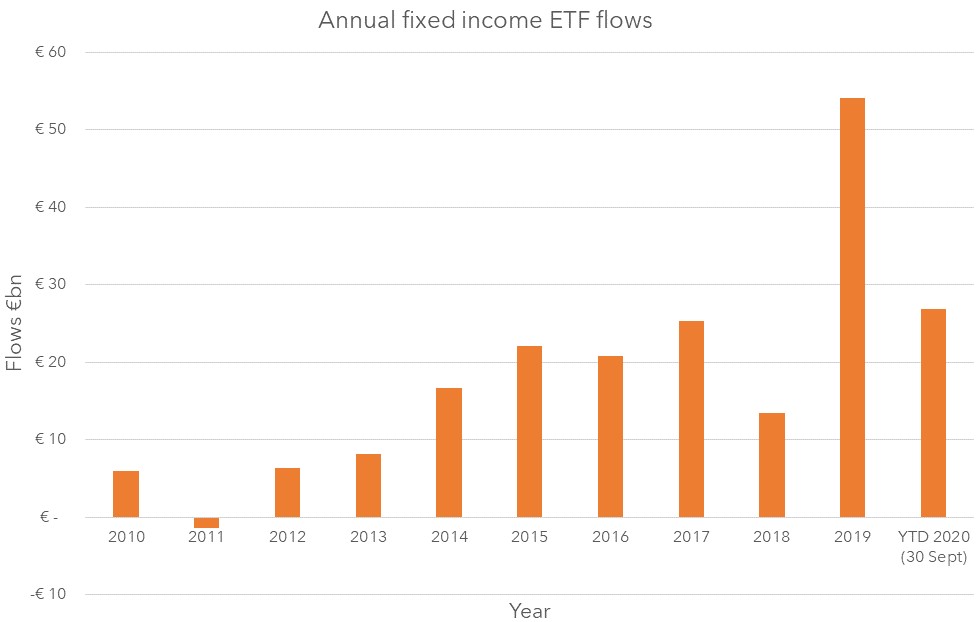Demand for fixed income ETFs in Europe has exploded over the past 18 months driven by ongoing ETF innovation, the modernisation of bond markets and the Federal Reserve’s decision to purchase ETFs for the first time in its history earlier this year.
According to data from Morningstar, the fixed income segment of the European ETF market has developed rapidly over the last five years with assets jumping from €95bn in 2015 to €257bn, accounting for over a quarter of the entire ETF ecosystem this side of the pond, as at 30 September.
In 2019, in particular, fixed income ETFs saw a record €54bn inflows in 2019, up from the previous high of €25bn positive flows set in 2017, while the segment has seen €27bn inflows so far this year.

Source: Morningstar
Brett Olson, managing director and head of iShares fixed income, EMEA, at BlackRock, said this rapid evolution was driven by a number of factors including a clearer thinking around portfolio construction, the modernisation of the bond market and ongoing ETF innovation.
With investors focusing more on costs as a result of regulation such as MiFID II and the low yield environment, Olson explained bond ETFs have provided the perfect tool for investors to deliver portfolio outcomes.
Furthermore, he argued the ETF ecosystem has developed rapidly in fixed income in recent years with market makers and authorised participants investing in technology which has led to tighter bid-offer spreads making the strategies more attractive for investors from a trading perspective.
Finally, there has been a sharp rise in bond ETF launches in recent years as investor demand for more precise exposures has increased. ETF issuers such as BlackRock now offer different maturity buckets across the yield curve, for example, so investors can home in on a very specific type of exposure.
Five fund buyers highlight areas for fixed income ETF innovation
Olson added the ability for issuers to create share classes that have different currency hedges instead of creating a whole new ETF has led to an operational efficiency where issuers are managing one larger pool of assets rather than a number of smaller ETFs. This also provides investors with solutions in a much shorter time frame.
“The last two years have been a major turning point for fixed income ETFs as all different investor-types have started to realise the benefits of the structure in their portfolios whether that be for tactical or strategic allocations or as a liquidity management tool,” Olson said.
His views were echoed by Jose Garcia-Zarate, associate director, passive strategies, manager research, Europe, at Morningstar, who said the instant access to the asset class investors got without having to engage with individual securities was one of the key drivers in bond ETF adoption.
“This has democratised access to all sorts of investors, and it is probably the greatest thing that ETFs have brought about when it comes to fixed income,” he added.
Liquidity test
Many critics of the ETF structure have claimed the wrapper created an “illusion of liquidity” by offering access to illiquid parts of the market.
The litmus test came during the sharp sell-off in March when the rapid spread of the coronavirus created a liquidity crunch leading to wide discounts on many bond ETFs.
According to analysis conducted by Citi, some 80% of investment-grade bond ETFs traded at all-time high discounts to their net asset values (NAVs) during this period.
What happens when the lights go out? An analysis of ETFs when liquidity vanishes
Instead of highlighting structural issues within ETFs, however, the wide discounts and subsequent premiums following the Fed’s decision to step into the market highlighted the “price discovery” role ETFs play.
As Garcia-Zarate said: “Many critics of bond ETFs expected that at a time of crisis and constrained liquidity conditions the ETF structure would collapse.
“The opposite happened and suddenly many investors understood the real benefits of the ETF structure when used to accessing bond markets.”
Olson added he saw a big uptick in interest for bond ETFs following the liquidity test especially from institutional clients who had not previously realised the benefits of the ETF structure especially during periods of market stress.
“The market disruption in March has led to investors using ETFs more,” he noted.
Federal Reserve
Along with passing a liquidity test, fixed income ETFs have also been bolstered by the Fed’s move into corporate bond ETF market for the first time in its history.
Through its Secondary Market Corporate Credit Facility (SMCCF) and executed by BlackRock, the Fed has poured $6.8bn assets into US-listed ETFs since it started purchases on 12 May, as at 17 June.
John Leiper, CIO at Tavistock Wealth, said the ongoing support from the US central bank has provided a strong tailwind for fixed income ETFs.
“A large part of the story is the increasing propensity for central banks to implement quantitative easing, or other supportive measures, via ETF purchases,” he added.
Analysing Europe’s five largest fixed income ETFs during the coronavirus pandemic
Another angle to the purchases as highlighted by Jordan Sriharan, head of MPS and passive and Canaccord Genuity Wealth Management (CGWM), is it shows investors the Fed believes that ETFs are “robust and efficient enough funnel significantly large investment through”.
“Up until now, many doomsayers had predicted the demise of bond ETFs on the grounds that when everyone headed for the exit door in a relatively illiquid and opaque asset class, ETFs would struggle to meet redemptions and might even have to ‘gate’ like a commercial real estate fund.
“In fact, ETFs provided better transparency around pricing as they moved from discounts, at the height of the panic, up to premium, as risk sentiment improved into Q2,” Sriharan continued. “This has improved the credibility of bond ETFs and woken multi-asset investors up to the prospect of finding a home for them in portfolios.”
This article first appeared inUnder The Spotlight: Investigating The Fixed Income ETF Revolution in partnership with iShares by BlackRock.






